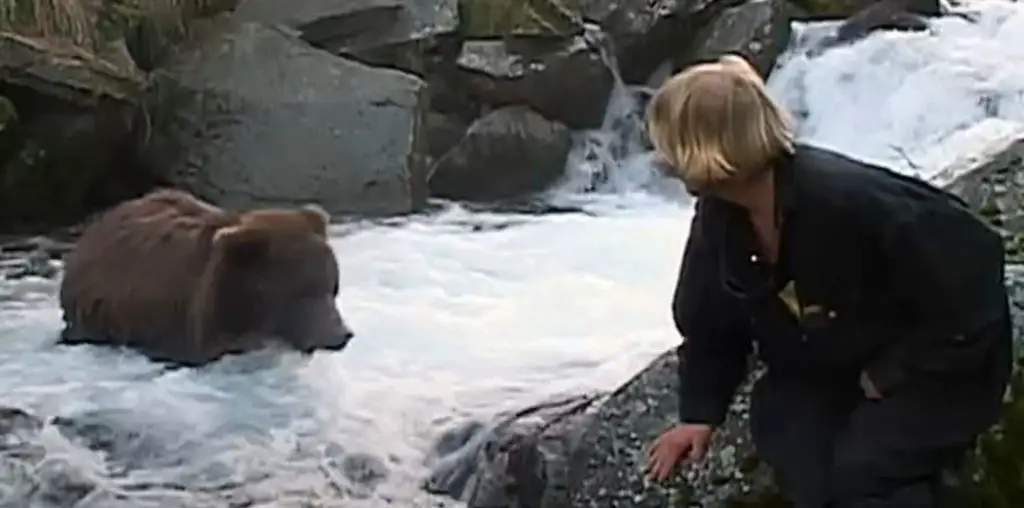
Just because a movie is bad does not necessarily mean it’s not worth exploring. I own a number of DVDs that I feel the movie missed the mark, but the commentary and the extra features way more than made up for it. Let’s be honest cinephiles, you can learn just as much (if not more) from a bad movie as from a good one.
Case in point. The DVD release of “Van Helsing”. Probably the pinnacle of the cinema of excess. Stephen Sommers could have taken a page from Sam Raimi’s “Spiderman”: “With great power comes great responsibility”. Ironically Raimi’s “Spiderman 2” works for the reasons that Van Helsing doesn’t. I might add that just because you can do anything in film doesn’t necessarily mean you should.
But as “American Beauty”‘s poster suggests “Look closer” and that’s what I did. I was afforded the opportunity to tour Industrial Light and Magic, the visual effects company behind “Van Helsing”, and get an up close and personal look at the creation of some of the more spectacular effects and you know what? There is actually something good that came out of this overbloated mess that may improve the quality of effects films by putting control of some of the effects back in the hands of the director.
I speak of a process called the Hybrid developed for the realization of the Dracula’s Brides (specifically for the attack on the town). Very simply put, this is a process that allows the director to shoot live elements of an actor while simultaneously recording motion capture of the same performance. In the case of the Brides, they were able to shoot the actress’ head giving a real performance while she wore a bluescreen suit that recorded her movement for the computer. Thus they were able to digitally create her body and seamlessly match it to her head in a far more efficient way.
Now you might ask, what’s the big deal?
The big deal is, in traditional motion capture, reflective markers were used on a body suit and filmed on a stage lit by fluorescent lights. It didn’t matter so much about the lighting because, all the camera cared about were the markers on the body and that’s all that was recorded. Having to shoot live action elements at the same time creates quite a big conundrum: How do you light the actress’ face for film without obliterating the ability to record the reflective markers that were completely wiped out by the massive amount of light necessary for film lighting.
We developed our own markers that instead of reflecting light – project light. The markers house high powered infra-red LEDs (that are) extremely bright – and easily detected by the motion capture cameras – but are ultimately invisible to the naked eye and to film. – Douglas Griffin (ILM Motion Capture Engineer)
Not impressed yet? Here’s the advantage. The new technology gives the Director the ability to actually direct a digital character and interact with them on set instead of waiting months later on a computer. Sommers personally oversaw the motion capture for all 45 Bride shots as well as the numerous shots of the computer generated Mr. Hyde and was able to get the nuances of the performance that he specifically wanted.
I was also treated to an insightful discussion of the design process for the 9 creatures (3 werewolves, pygmy bats, 3 brides, Hyde, Dracula Hell Beast) that make up the Van Helsing world and discovered that Frankenstein’s Monster was originally going to be amongst them (until the task was turned over to the real-world Make-Up FX team at Captive Audience) as well as an appearance by The Creature From The Black Lagoon which apparently was in the original draft of the script.
The 10 man design team generated over 1,200 different pieces of artwork for the film and, par for the course, Sommers’ “more is more” aesthetic was the mantra of the department.
If it’s a monster, it’s got to be really big, muscular and badass. (Sommers) referred to the Werewolves and Dracula as Badass rock stars. – Douglas Griffin (ILM Motion Capture Engineer)
It was also interesting to note how the designs influenced the movie itself.
One of our designers, Brian O’Connell, put Hyde on the roof of Notre Dame so you could see all of Paris in the background. Stephen saw it and remarked “what was I thinking, I was going to have this entire fight take place inside (Notre Dame) now I’m going to have it take place outside”. – Christian Alzmann (ILM Visual Effects Art Director)
My final visit was with Ben Snow the Visual Effects Supervisor on Van Helsing who remarked that “Stephen likes to put a lot in his movies”.
Well folks, he likes to put a lot in his DVDs as well.
I’ll have to give Universal credit for packing this turkey of a movie full of tasty stuffing. The features far out surpass the movie in all aspects. Not only do you get indepth discussions on the creation of the more involved effects sequences as well as how each creature was conceived and influenced, but you get this interesting guided tours of some of the actual sets from the film.
A great deal of money was spent on this film and you can certainly see it in the lavish detail of the massive sets, especially Frankenstein’s lab. It’s a shame that Sommers couldn’t slow down the camera once in a while to show off the work (or at the very least let the story breathe).
Am I recommending you buy this DVD?
Well, If you enjoy Behind the Scenes Featurettes and having the opportunity to see how a “mega-blockbuster” is conceived and executed than yes, you will certainly get your money’s worth. If you’re buying it for the film, well caveat emptor.
